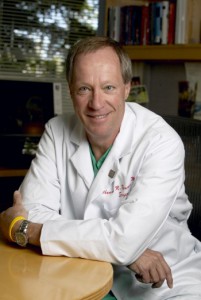 Innovation is inherent in surgery, says Thomas Krummel, MD, so for surgeons, the gap in launching an innovation isn’t the invention process but in the commercialization process. “Discovery and emerging technologies have shaped surgical practice from the start,” he said at a lecture at Boston Children’s Hospital this summer titled “Building on Robert E. Gross’s Legacy of Innovation.”
Innovation is inherent in surgery, says Thomas Krummel, MD, so for surgeons, the gap in launching an innovation isn’t the invention process but in the commercialization process. “Discovery and emerging technologies have shaped surgical practice from the start,” he said at a lecture at Boston Children’s Hospital this summer titled “Building on Robert E. Gross’s Legacy of Innovation.”
Krummel, who co-directs the Biodesign Innovation Program at Stanford University and and is Surgeon-in-Chief at the Lucile Packard Children’s Hospital, challenged his audience of residents and surgeons. “A surgeon in an academic department must pull a new rabbit out of his hat” with some frequency, he argued, pointing to historical examples ranging from the pulse oximeter to the more recent development of the video laparoscopic camera.
He also noted the variety of attitudinal approaches that surgeons can take to potential innovations. Some involve fear, and some surgeons try to ignore the potential for change, hoping it will go away. In Krummel’s estimation, “that is not a very surgical approach.”
Surgeons are uniquely positioned to be innovators, he argues, because they see the clinical gaps in care and what requires further investigation to create a solution. “We, as surgeons, best understand the realities of how to bring these solutions to the bedside. Thus, the surgeon-investigator, while an endangered species, should never become extinct, because everything we use is manufactured.”
Getting products from the bench to bedside typically involves four steps: discovery, invention, innovation and entrepreneurship. “There is good reason for surgeons to be involved with each of these steps in the process,” Krummel said.Understanding the commercial step of the process is where most surgeons fall short. In their training, surgeons are not required to study economics or business, which are integral for this step. Recognition of this gap was the genesis of Stanford’s Biodesign Innovation Program 12 years ago.
But each of the steps holds unique and distinct considerations:
• Discovery: The greatest advances in medicine have come from unfettered investigator-initiated inquiry and discovery, such as recombinant DNA. However, the discovery process does not always occur in an organized fashion or with a specific clinical problem in mind—it is sometimes even chaotic. “University labs are best equipped for this step,” he noted.
• Invention: While an invention can be an object or process, it is more importantly a technique mentally fabricated with element of novelty, according to Krummel. Frequently, an invention is built on pre-existing concepts. For instance, Dr. Thomas Fogarty’s embolectomy balloon catheter, though having the unique application of extracting emboli and thrombi in the arterial system, is built on previous iterations of the balloon catheter.
• Innovation: Innovation is the idea put into practice, which is distinct from invention. “If invention is the idea, innovation is the application,” he said. “If you have a good idea, and you don’t develop it, it does not achieve this step of innovation.”
• Entrepreneurship: This commercial step is required for an innovation to transition out of the lab to a patient. An entrepreneur is someone who undertakes and operates a new enterprise or venture and assumes considerable responsibility for its success. Thus, the entrepreneur seeks independence, autonomy and control to maximize the likelihood of success. “These adjectives are often used to describe surgeons,” Krummel pointed out. “We are programmed as problem-solvers.”
In order for inquisitive people to succeed, they must be allowed to explore, permitted to fail and given credit for their successes, Krummel noted; this requires a permissive and celebratory environment.
Some current barriers, however, have created a dearth in the pipeline of surgeon-innovators, including:
• Surgeon’s views are narrowing, creating a specialization/treadmill mentality.
• Technology is increasingly complex and expanding.
Nonetheless, Krummel believes there is still opportunity for the right people in the right environment. He quoted a prominent surgeon pioneer—the late Mark M. Ravitch, MD, a leading pediatric surgeon and U.S. pioneer in the use of mechanical stapling devices used in gastrointestinal surgery.
“Surgery is not a place or procedure,” Ravitch said, “but an intellectual discipline characterized by operative procedures by defined by an attitude of responsibility toward the care of the sick.”










